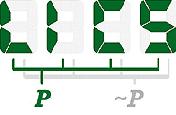Paper: Semantics of a Sequential Language for Exact Real-Number Computation (at LICS 2004)
Authors: J. Raymundo Marcial-Romero Martin H. EscardoAbstract
We study a programming language with a built-in ground type for real numbers. In order for the language to be sufficiently expressive but still sequential, we consider a construction proposed by Boehm and Cartwright. The non-deterministic nature of the construction suggests the use of powerdomains in order to obtain a denotational semantics for the language. We show that the construction cannot be modelled by the Plotkin or Smyth powerdomains, but that the Hoare powerdomain gives a computationally adequate semantics. As is well known, Hoare semantics can be used in order to establish partial correctness only. Since computations on the reals are infinite, one cannot decompose total correctness into the conjunction of partial correctness and termination as it is traditionally done. We instead introduce a suitable operational notion of strong convergence and show that total correctness can be proved by establishing partial correctness (using denotational methods) and strong convergence (using operational methods). We illustrate the technique with a representative example.
BibTeX
@InProceedings{MarcialRomeroEscard-SemanticsofaSequent,
author = {J. Raymundo Marcial-Romero and Martin H. Escardo},
title = {Semantics of a Sequential Language for Exact Real-Number Computation},
booktitle = {Proceedings of the Nineteenth Annual IEEE Symp. on Logic in Computer Science, {LICS} 2004},
year = 2004,
editor = {Harald Ganzinger},
month = {July},
pages = {426--435},
location = {Turku, Finland},
publisher = {IEEE Computer Society Press}
}
